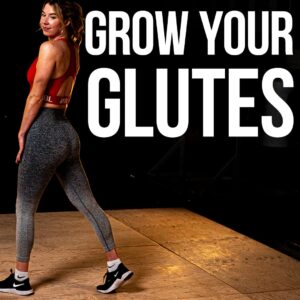The Glutes, also known as the butt muscles, have become one of the most popular muscle groups to train. This is for a lot of reasons, but most likely for three main reasons.
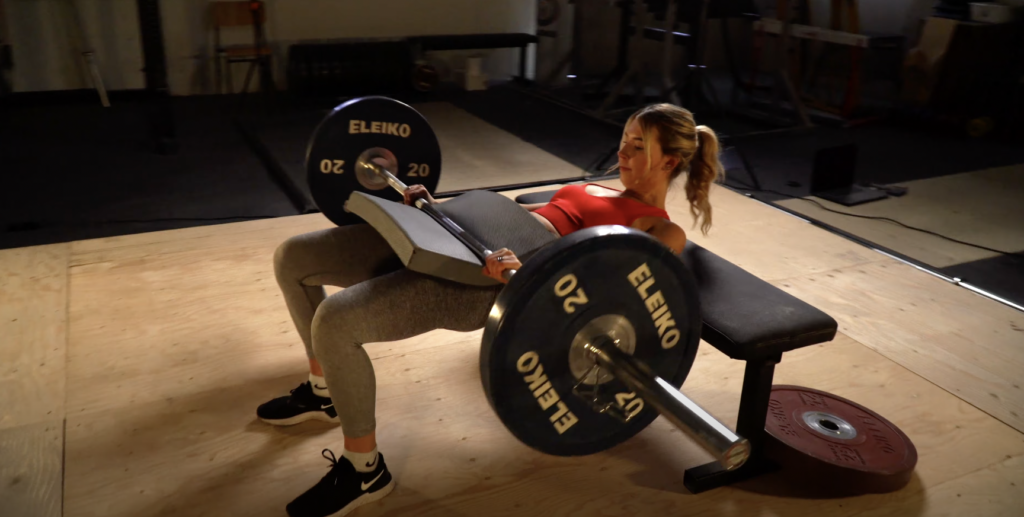
1- The glutes obviously are a huge facet of someone’s lower body physique and a popping booty stands out really well.
2- The glutes are incredibly important for sporting performance, helping generate a ton of force for moving us in different directions.
3- The glutes are often viewed as a critical muscle group to train for various aches and pains people may be experiencing.
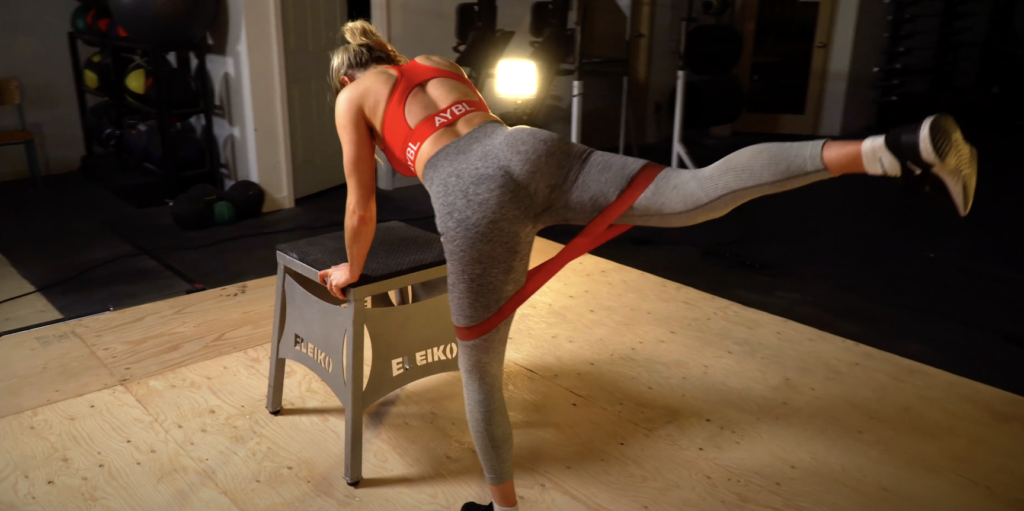
Many people spend time training their glutes, but they often fall short of making a good change in their glutes. This is due to poor exercise selection, poor exercise technique and many other factors we’re going to tackle today.
In deciding the best exercises for the glutes, we need to understand their anatomy, both in general and regionally, their functions, their length tension relationships, and how to practically challenge them.

Glute Anatomy
When we look at the anatomy of the glutes, we are actually looking at three muscles:
The Gluteus maximus
The Gluteus medius
And the gluteus minimus

The gluteus maximus is the largest of the three. It makes up about 75% of the volume of the booty, and is the largest muscle in the human body.
It originates on the back side of the body, along the ilium and sacrum and then runs downwards and laterally over to the gluteal tuberosity of the femur and IT band where it inserts.
Due to these origins and insertions, we see the glute max performs hips extension, hip abductions, and hip external rotation. When we look at the glute max closer, we can see that it actually has two primary subdivisions. The upper glute max and lower glute max.
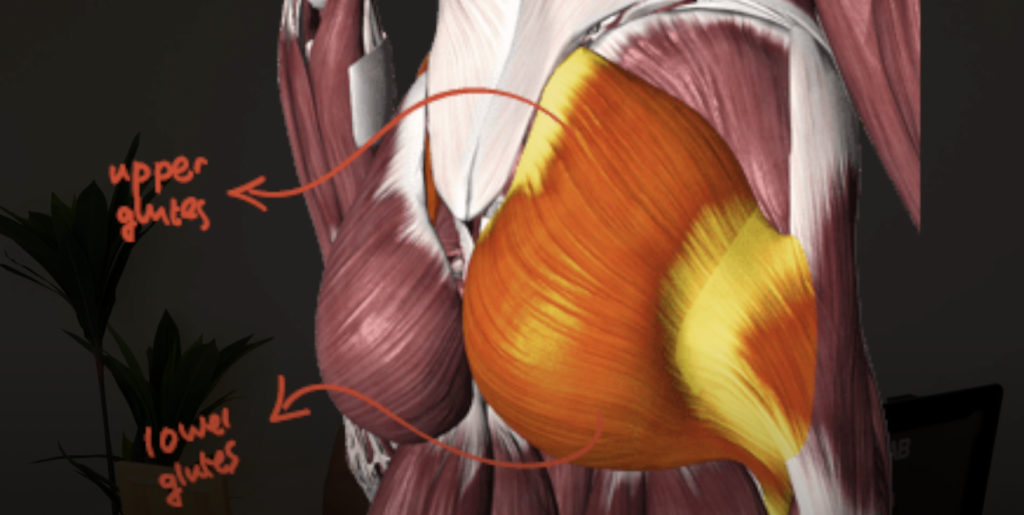
The upper glute max contributes to all three motions, but primarily performs hip abduction and hip external rotation.
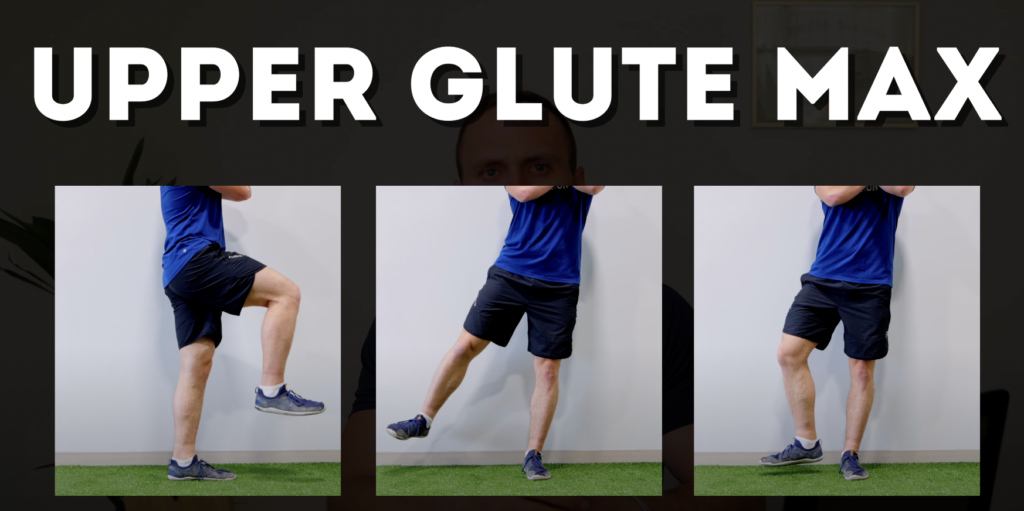
In contrast, the lower glute max minimally assists with hip external rotation and hip abduction. Instead primarily performs hip extension.

The glute medius is the second largest of the three muscles. It contributes to about 18.5% of the volume of the backside.
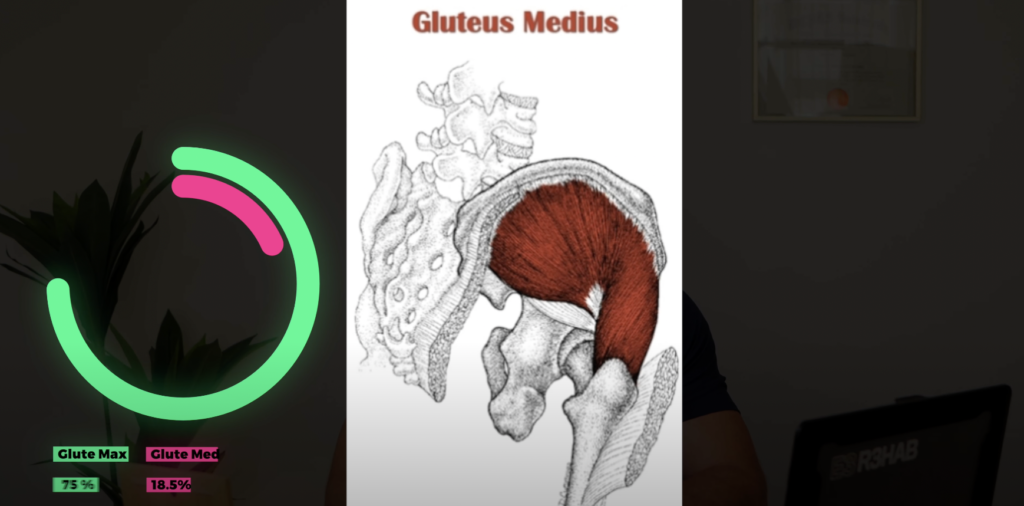
It originates up on the lateral side of the ilium and then runs in a fan shaped direction downwards to the greater trochanter of the femur.
Based on these attachments, the glute med primarily does hip abduction, with some contribution towards hip extension, hip external rotation, hip flexion, and hip internal rotation.
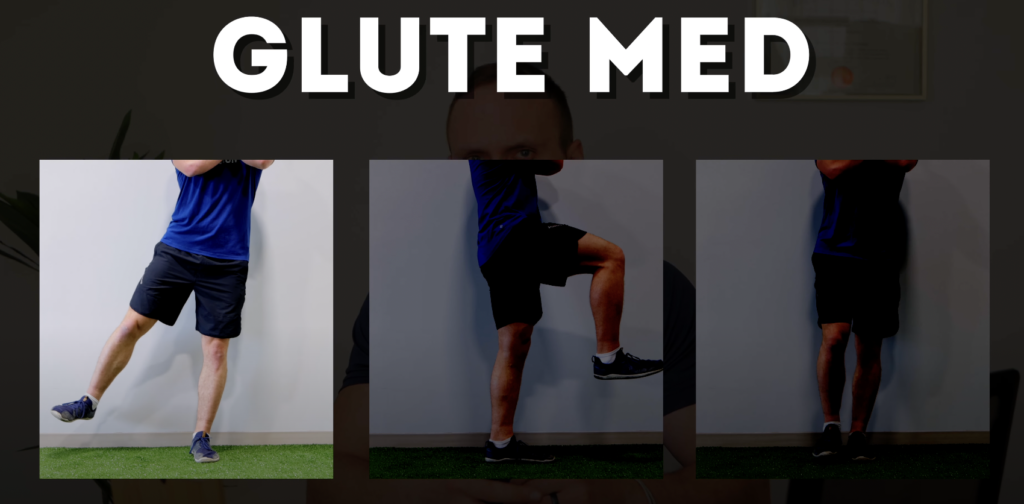
If we look more closely at the glute med, we can see that there are actually three subdivisions, an anterior part, a middle part, and a posterior part, helping to explain the various actions.
All three of these parts assist in hip abduction, but the anterior part also does hip flexion and internal rotation, and the posterior part also does hip extension and hip external rotation.
Since the gluteus minimus only accounts for 5-8% of the volume and works very hard through hip abduction, and get worked effectively training the other two glute muscles, we aren’t going to be focusing on it.
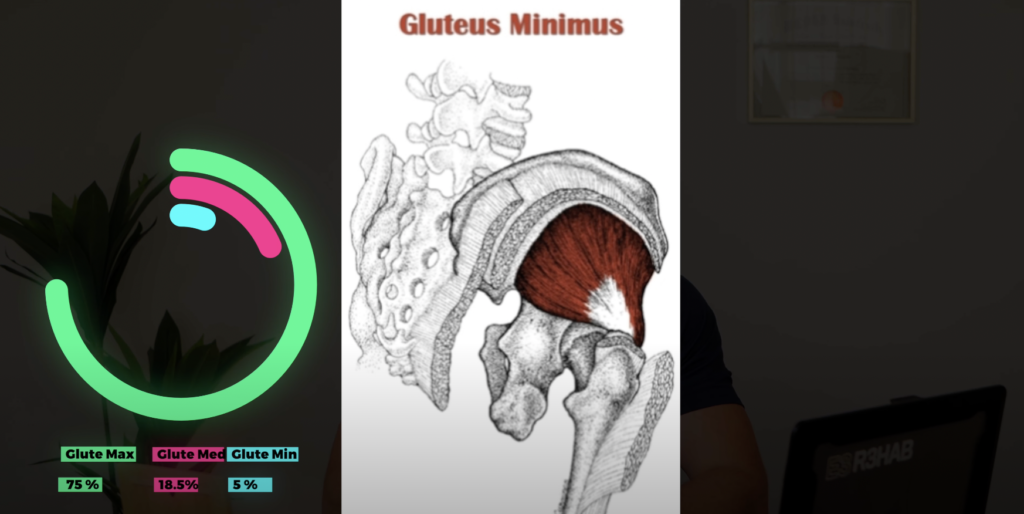
Now when it comes to deciding the best exercises for these muscles, it’s not just about what actions they do. If that were the case, we could just do any hip extension, abduction, or external rotation movement and grow a huge booty.
In reality though, that’s where many people go wrong.
Instead, we want to look at when these muscles work best, and get worked more than other muscles that also do these actions.
Exercise Selection
When we look at the glute maxes function more in depth, we can see that during hip extension, it has the best leverage over other hip extensors towards full hip extension.
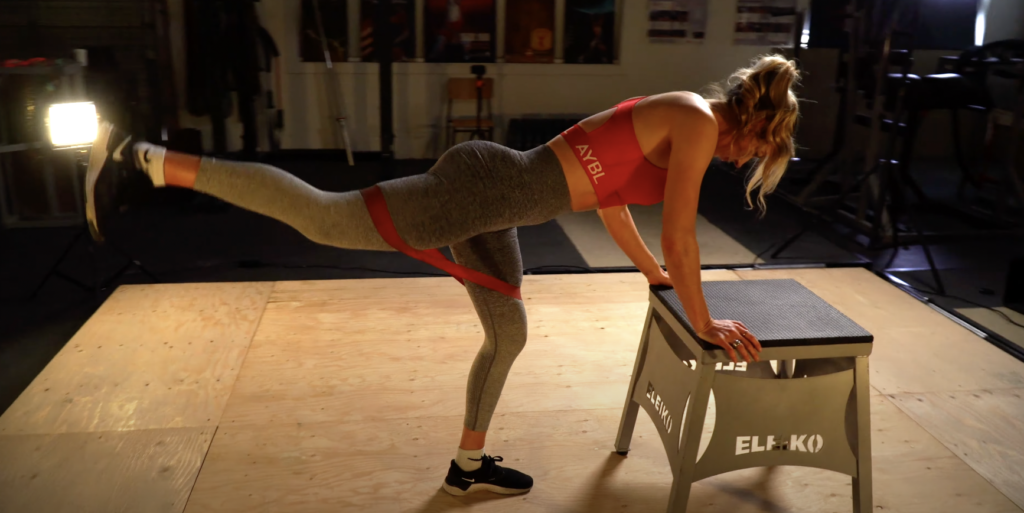
During hip external rotation, it appears that having more of a challenge towards the end range of hip external rotation is best for eliciting the most challenge from the glute max.

And for hip abduction we see a similar trend where the glutes will be worked best towards terminal hip abduction, instead of closer to hip adduction.
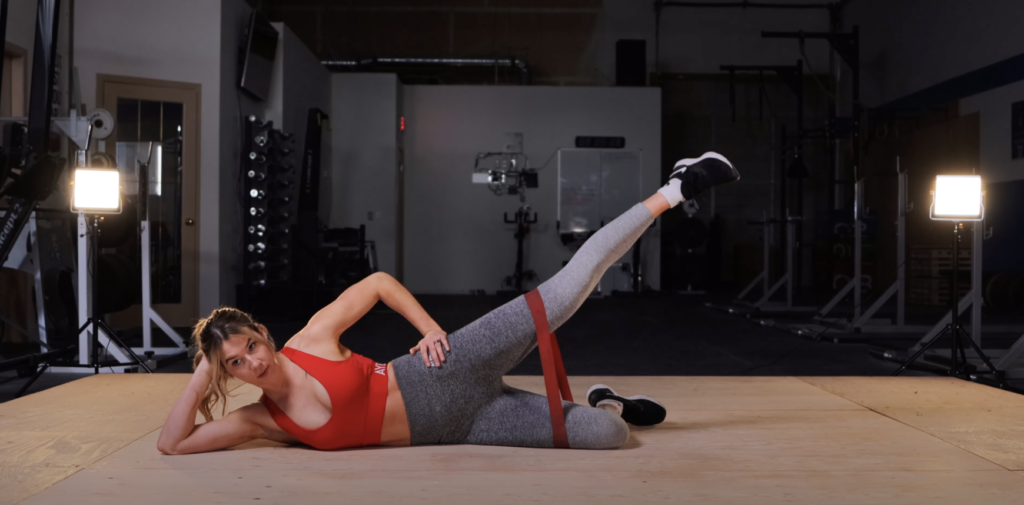
For the glute med, since it has some overlapping actions as the glute max, particularly the upper fibers of the glute max, it’s often best to focus more towards the opposite actions. That’s why the glute med is often best trained in a hip extended and hip internally rotated position, working on hip abduction.
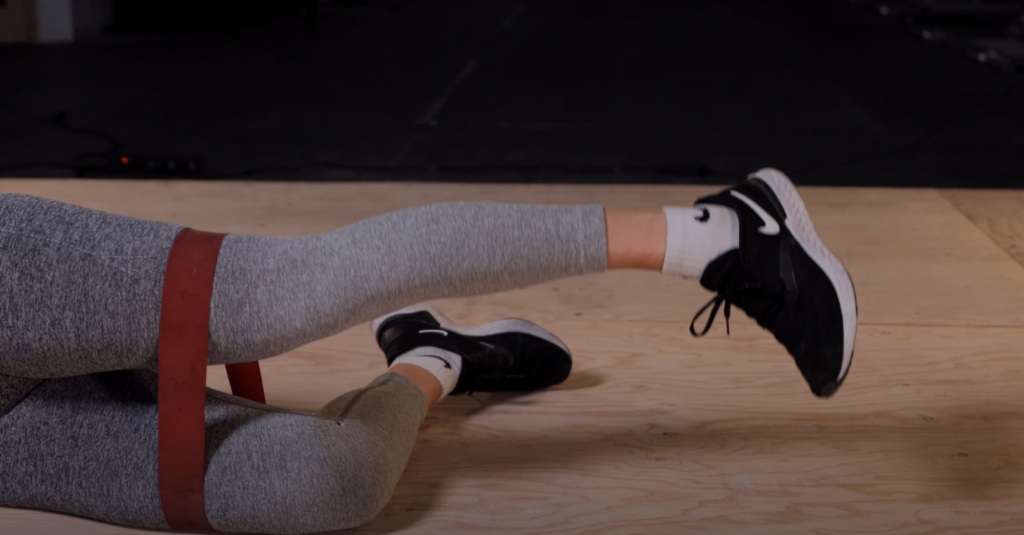
This helps to also minimize working the other hip abductors like TFL, in favor of focusing on the glute med.
When we consider these details, we can start to pick movements that match up with these for picking the best exercises.
The first exercise that many people will tout for the glutes is the squat.
Squat
The squat has become so popular for the glutes that it has a cult following known as squat for a butt.
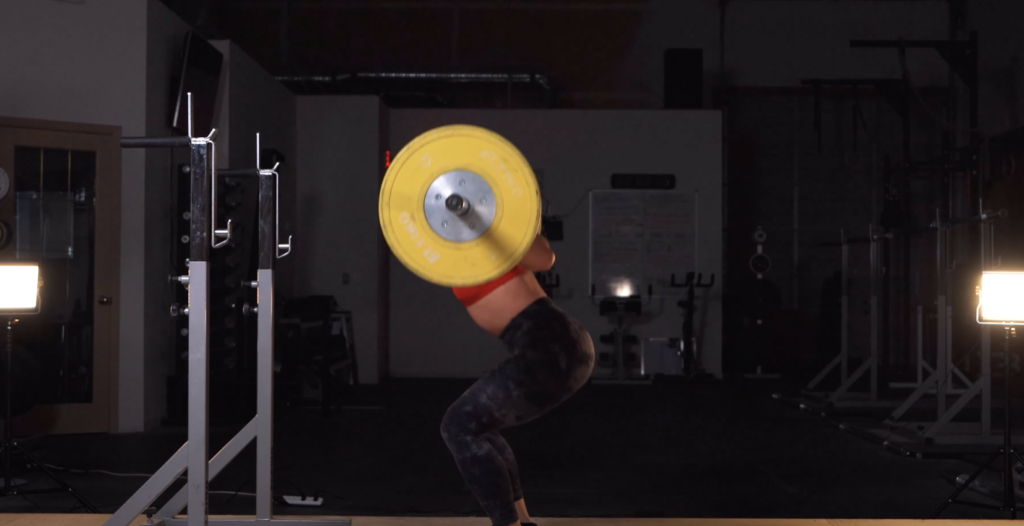
A study from Kubo et al. 2019 actually examined how squat training for 10 weeks affected muscle growth for different muscles and saw the glute max increased size by 6.7% on average, which is quite substantial.
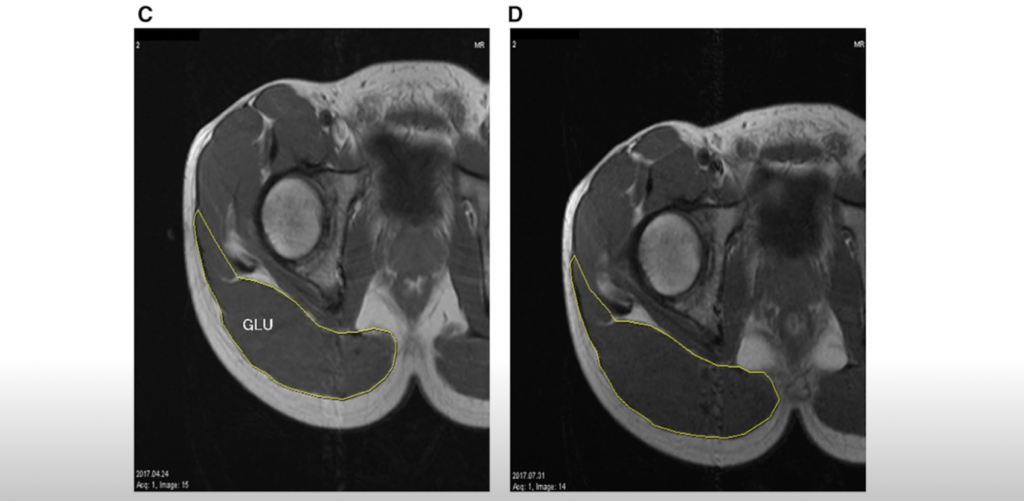
In particular, they demonstrated that if you’re going to squat for glute growth, you want to do deep squats as full squats resulted in approximately three times as much growth for the glutes as half squats.
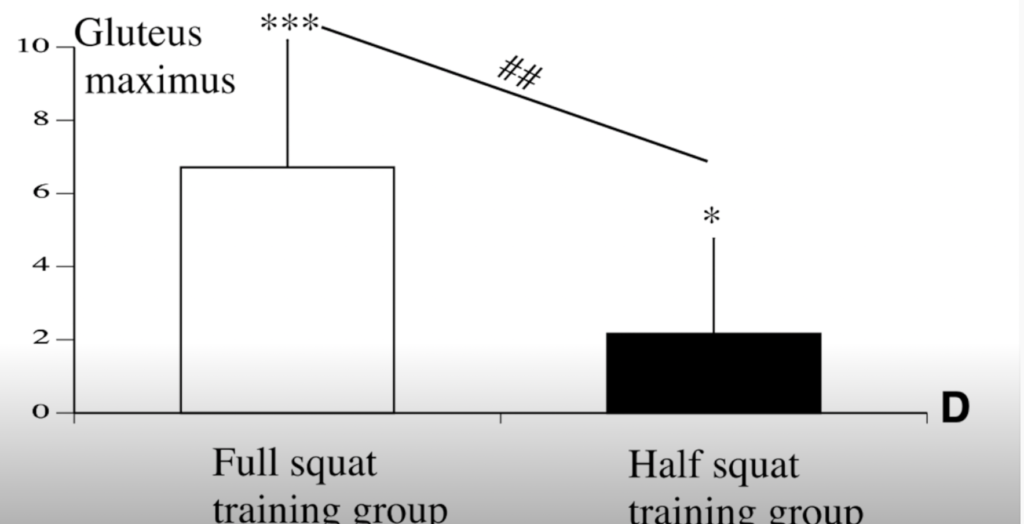
With that said, one argument against the squat is that it is also a very effective quadriceps and adductor exercise. Typically when people are looking for THE BEST glute exercises, they’re looking for an exercise that emphasizes the glutes over the legs.
As well, since a lot of people are already squatting in their program and looking to add on glute exercises, I don’t know if I would call it the BEST GLUTE exercise.
That’s where these other exercises come in. The first exercise is the hip thrust.
Hip Thrust
The hip thrust has demonstrated the highest glute EMG readings for compound exercises and regularly shows best results for glute growth in research.
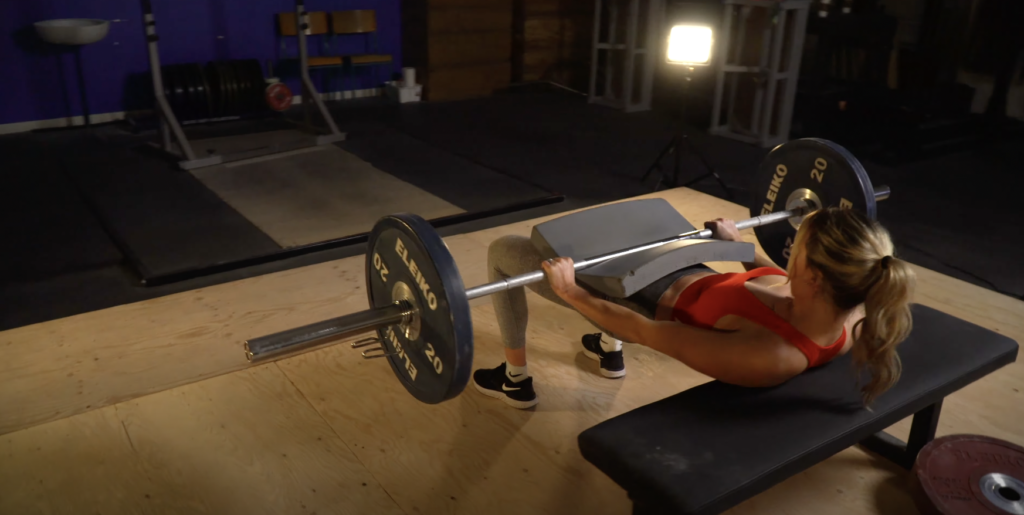
With that said, we want to make sure we perform the exercise appropriately to get the most out of it.
First thing is finding something to have your shoulders supported on, that is going to be sturdy and not moving. Ideally you get something that is right around bottom of your knee cap for height. This will put you in an ideal position to get the most out of your glutes during the movement.

This can be an issue for a lot of people, so if you find that the height of the bench or box you go to use is too high, consider elevating your feet to allow you to get better positioning.
When you do the movement, make sure to use a squat pad, airex pad, or some other sort of thick material to stop the bar from digging into your hip.
From here, drive the hips up and think about doing a mini crunch and bringing your belt buckle to your chin. This will encourage you to get into full hip extension and get some posterior pelvic tiling for maximum glute engagement.
Two more important details on this exercise are the knee angle and the foot position.
When we get to the top of the hip thrust, we want about a vertical shin. A recent paper from Garcia et al. 2020 found when the feet were further out, the glute activity went down, and the hamstring activity went up.
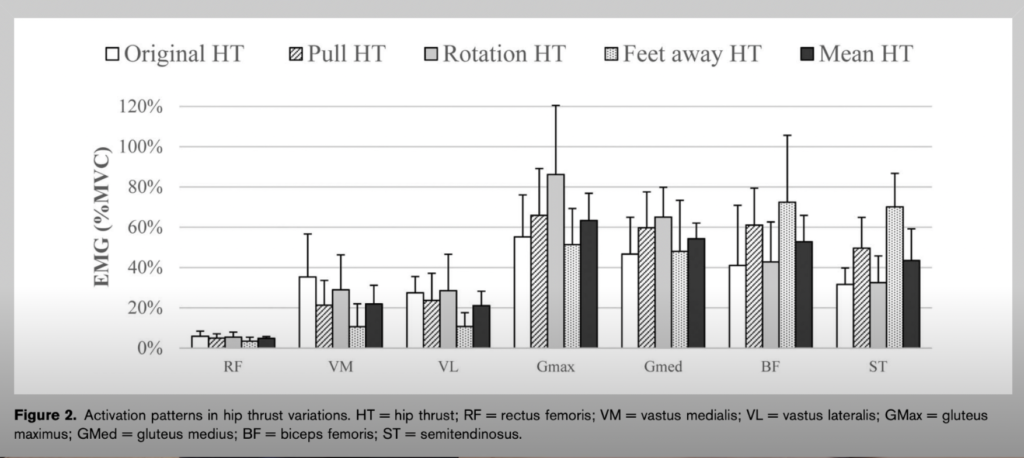
With the feet further out, we have to resist the knees from extending, making the hamstrings work to flex the knee and extend the hip together.
Garcia’s study also found that by taking a slightly wider foot stance and having the toes turned out, they were able to get more glute max and glute med.
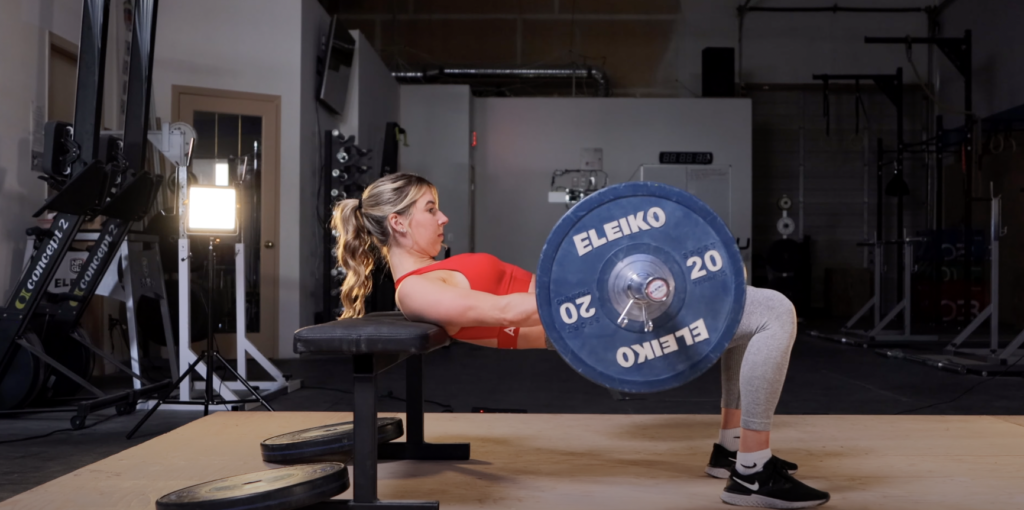
This makes a lot of sense when we look at the fibers of the glute again. Since they run downwards and on an angle out, having a bit wider stance should encourage more usage.
Now if you can’t set up a hip thrust for whatever reason, you can do a standard glute bridge with a barbell on the ground as well.
Now after the hip thrust and it’s variants, the next best glute exercise is the sumo deadlift.
Sumo Deadlift
Deadlift variations in general use the glutes to a very high degree.
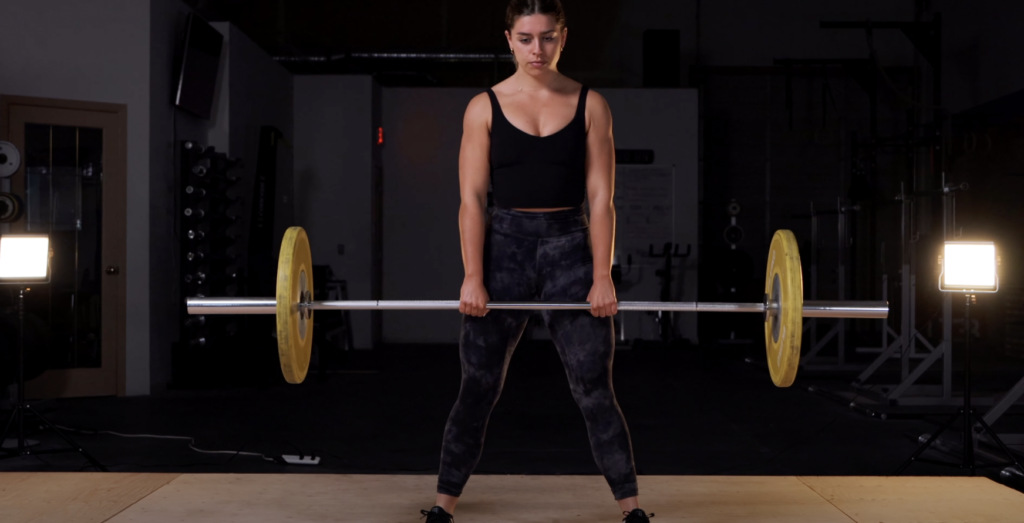
The sumo deadlift in particular has good potential to challenge the glutes because it takes the glutes to a greater degree of hip abduction and hip external rotation.
When executing the sumo deadlift to maximize glute challenge, consider experimenting with a wider foot stance to get that end range abduction we discussed. A more toes out position to take the glutes to their end range externally rotated position as well.
One last thing to think about experimenting with is going to a deeper range of motion, also known as a deficit. Since the glutes get stretched when the hip flexes, going into a deeper range may be beneficial. This can be done through standing on something, or using smaller plates than usual.
Now the squat, hip thrust, and sumo deadlift are all bilateral exercises, meaning you do them with both legs.
Bilateral exercises are great since they are stable and work well with heavier loading, but when we consider the functions of the glutes again, it’s important we start considering unilateral exercises.
Unilateral Exercises
A unilateral exercise is where we only use one leg, like a single leg squat, single leg deadlift, or single leg hip thrust.
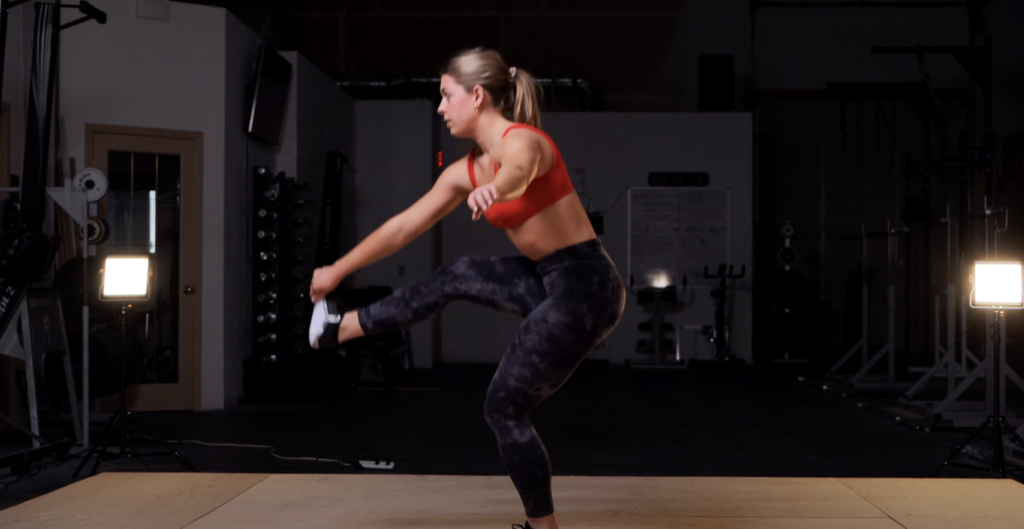
When we do these versions of the movement, our glutes have to work really hard to maintain our pelvis position side to side, and rotationally.
Some unilateral exercises have shown very similar glute demands to their bilateral counterparts, so it’s a set of movements that shouldn’t be neglected.
When it comes to picking the absolute best exercises, the single leg deadlift with a landmine attachment and perpendicular loading is probably one of the best.
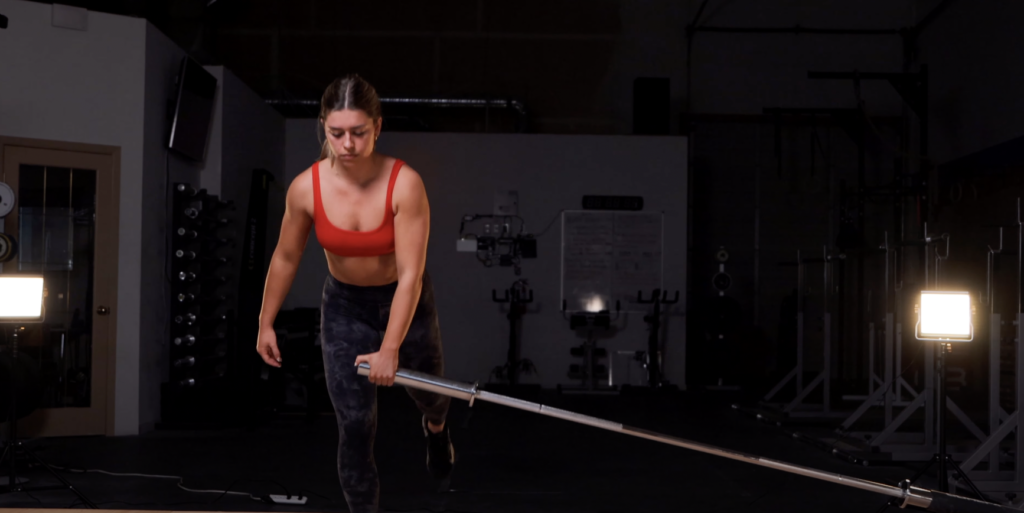
With it’s challenge on resisting rotating as the bar comes across the body, and maintaining the pelvis position, it’s a great booty builder.
The step up has also been shown to have a high demand on the glutes, particularly when done at higher heights.
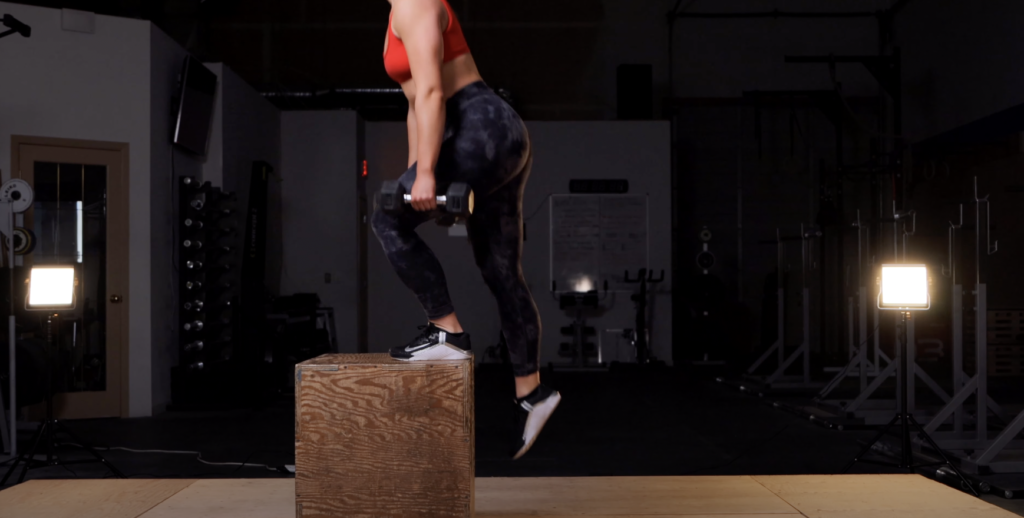
You can see that when we drive up and our rear foot leaves the ground, our glutes have to work to not let our hip drop down. Generally loading this up with a pair of dumbbells will be best.
And then the we’d be hard pressed to not include the single leg hip thrust.
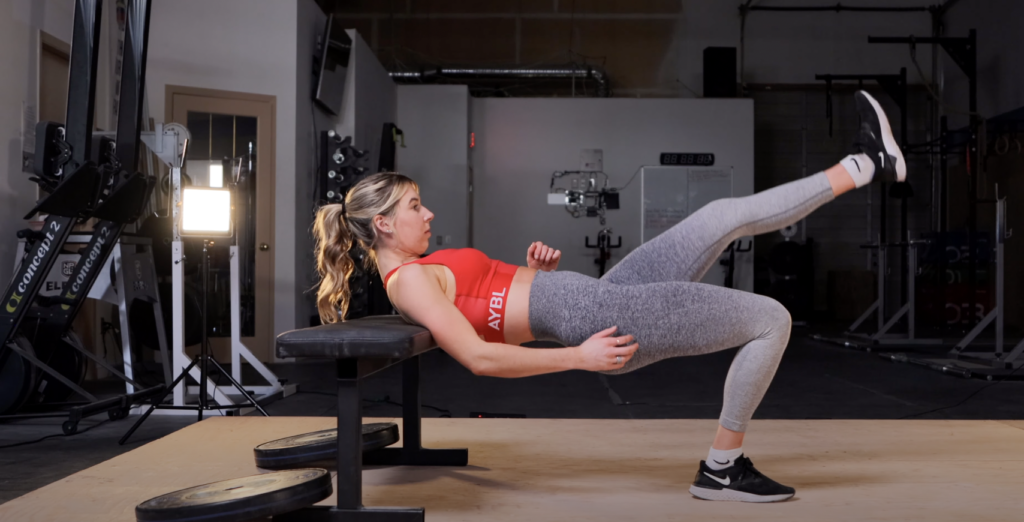
However, I will say that I think doing a deficit single leg hip thrust is a great one to particularly include since it lets you get into a deep stretch and work through more range. You can load it up with a dumbbell or a barbell across the lap.
Now the movements we’ve discussed so far are what should make up the bulk of glute focused training since these compound movements challenge the glutes the best overall, but these movements do emphasize hip extension more than hip abduction and hip external rotation.
To really round out a comprehensive best glute exercise list, we need to include some of the best exercises for these movements.
Hip Abduction
When looking at hip abduction, there are two top exercises.
Firstly the very popular Side stepping exercise. This can be a very effective exercise for working the glutes, particularly the glute med.

If you want to get the most out of this exercise, it’s important that we dial in a few techincal factors:
- Keep the knees driving out
It’s common people will let their knees come in while stepping to the side, but that reduces how much abduction we do and takes away from the glute med working hard.
- Keep the toes forward.
This helps to emphasize the glute med over the TFL as we work on abducting.
- Try not to go and up down, but instead keep a level position going side to side.
Bobbing up an down will start loading the thighs more and take away from the glutes working as hard.
People commonly ask where is the best spot to put the band, and while the band position makes a bit of a difference, what matters more is the previous points.
Start with your band at the knees and if you need to increase the challenge, move it to your ankles. Then if you want to increase the challenge further, move it to your toes.
The second exercise for hip abduction is the side lying hip abduction exercise.

The last move is fantastic, but it technically isn’t a pure hip abduction exercise. That’s where the side lying hip abduction exercise really shines.
In this exercise we keep our knee straight while moving our leg, and if we keep the toes forward like the last exercise, we can make it a pure hip abduction exercise. While doing this exercise, along with keeping your toes forward, you also want to focus on moving at the hip and not just hiking your hip up and down.
Just like with the last exercise, starting with the band at the knees, then moving it down as you increase in strength is often best.
Those two exercise will cover hip abduction really well.
Hip External Rotation
As we start to look more towards hip external rotation, there are a few exercises which work really to round out the list of movements we’ve looked at so far.
The first is the classic clamshell.

This exercise works on pure hip external rotation. Traditionally this movement has been done at around 45 degrees of hip flexion. However, as we’ve seen the glute fibers have various lines of pull, it can be beneficial to vary this angle to work different fibers to different degrees.
That’s why I like the three position clamshell where we go through a hip extended clamshell for a certain number of reps, then do the 45 degree hip flexion version for a number of reps. Then bring the knees up more towards 90 degrees of hip flexion for more reps.
This can be a really challenge version and light up the whole glute.
The second exercise that we can look to use is the banded supine hip external rotation.
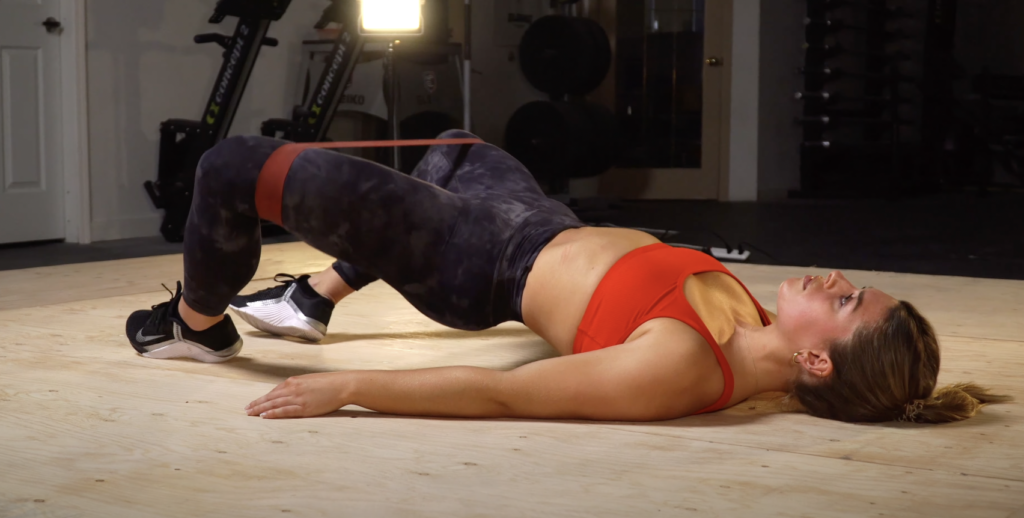
With this we’re laying on our back and rotating out against the band. In this position it is a bit of external rotation and abduction, but that’s going to happen often with these kind of moves.
Now something that can be really good about this move is that we can do it with our hips on the ground without any challenge towards hip extension, or we can lift our hips up and have our glutes working extra time to maintain a hip extended position while going through hip external rotation and abduction.
This exercise really emphasizes the more hip extended position, which will work that upper glute fibers to a really good degree.
Generally doing these kinds of exercises for max reps or a “burn out” is best since we aren’t going to be able to load them up to a really high degree like hip thrusts or deadlifts.
And with that, we’ve covered the BEST GLUTE exercises.
Thanks for reading everyone!
If you want some additional details, and hear us speak to our friend Brett Contreras, check out the video we made on this topic, right here:


